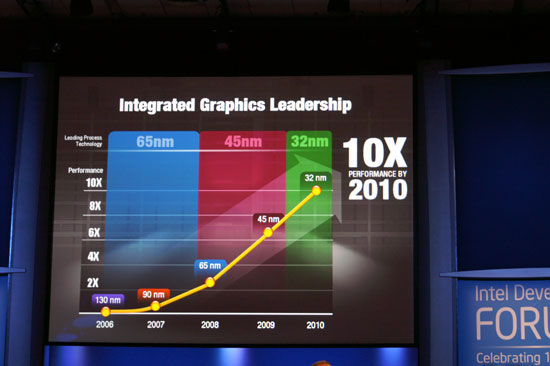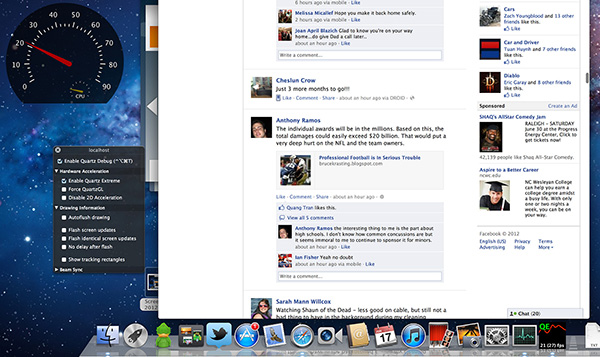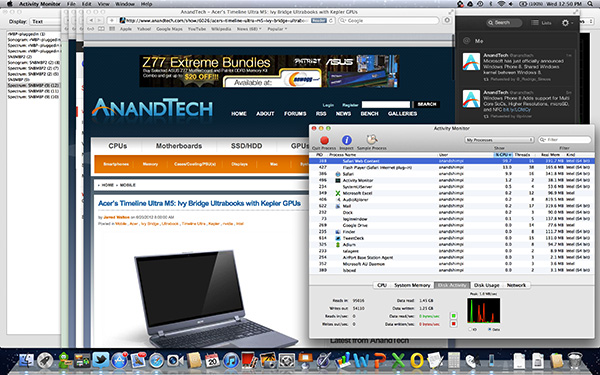The next-gen MacBook Pro with Retina Display Review
by Anand Lal Shimpi on June 23, 2012 4:14 AM EST- Posted in
- Mac
- Apple
- MacBook Pro
- Laptops
- Notebooks
Driving the Retina Display: A Performance Discussion
As I mentioned earlier, there are quality implications of choosing the higher-than-best resolution options in OS X. At 1680 x 1050 and 1920 x 1200 the screen is drawn with 4x the number of pixels, elements are scaled appropriately, and the result is downscaled to 2880 x 1800. The quality impact is negligible however, especially if you actually need the added real estate. As you’d expect, there is also a performance penalty.
At the default setting, either Intel’s HD 4000 or NVIDIA’s GeForce GT 650M already have to render and display far more pixels than either GPU was ever intended to. At the 1680 and 1920 settings however the GPUs are doing more work than even their high-end desktop counterparts are used to. In writing this article it finally dawned on me exactly what has been happening at Intel over the past few years.
Steve Jobs set a path to bringing high resolution displays to all of Apple’s products, likely beginning several years ago. There was a period of time when Apple kept hiring ex-ATI/AMD Graphics CTOs, first Bob Drebin and then Raja Koduri (although less public, Apple also hired chief CPU architects from AMD and ARM among other companies - but that’s another story for another time). You typically hire smart GPU guys if you’re building a GPU, the alternative is to hire them if you need to be able to work with existing GPU vendors to deliver the performance necessary to fulfill your dreams of GPU dominance.
In 2007 Intel promised to deliver a 10x improvement in integrated graphics performance by 2010:

In 2009 Apple hired Drebin and Koduri.
In 2010 Intel announced that the curve had shifted. Instead of 10x by 2010 the number was now 25x. Intel’s ramp was accelerated, and it stopped providing updates on just how aggressive it would be in the future. Paul Otellini’s keynote from IDF 2010 gave us all a hint of what’s to come (emphasis mine):
But there has been a fundamental shift since 2007. Great graphics performance is required, but it isn't sufficient anymore. If you look at what users are demanding, they are demanding an increasingly good experience, robust experience, across the spectrum of visual computing. Users care about everything they see on the screen, not just 3D graphics. And so delivering a great visual experience requires media performance of all types: in games, in video playback, in video transcoding, in media editing, in 3D graphics, and in display. And Intel is committed to delivering leadership platforms in visual computing, not just in PCs, but across the continuum.
Otellini’s keynote would set the tone for the next few years of Intel’s evolution as a company. Even after this keynote Intel made a lot of adjustments to its roadmap, heavily influenced by Apple. Mobile SoCs got more aggressive on the graphics front as did their desktop/notebook counterparts.
At each IDF I kept hearing about how Apple was the biggest motivator behind Intel’s move into the GPU space, but I never really understood the connection until now. The driving factor wasn’t just the demands of current applications, but rather a dramatic increase in display resolution across the lineup. It’s why Apple has been at the forefront of GPU adoption in its iDevices, and it’s why Apple has been pushing Intel so very hard on the integrated graphics revolution. If there’s any one OEM we can thank for having a significant impact on Intel’s roadmap, it’s Apple. And it’s just getting started.
Sandy Bridge and Ivy Bridge were both good steps for Intel, but Haswell and Broadwell are the designs that Apple truly wanted. As fond as Apple has been of using discrete GPUs in notebooks, it would rather get rid of them if at all possible. For many SKUs Apple has already done so. Haswell and Broadwell will allow Apple to bring integration to even some of the Pro-level notebooks.
To be quite honest, the hardware in the rMBP isn’t enough to deliver a consistently smooth experience across all applications. At 2880 x 1800 most interactions are smooth but things like zooming windows or scrolling on certain web pages is clearly sub-30fps. At the higher scaled resolutions, since the GPU has to render as much as 9.2MP, even UI performance can be sluggish. There’s simply nothing that can be done at this point - Apple is pushing the limits of the hardware we have available today, far beyond what any other OEM has done. Future iterations of the Retina Display MacBook Pro will have faster hardware with embedded DRAM that will help mitigate this problem. But there are other limitations: many elements of screen drawing are still done on the CPU, and as largely serial architectures their ability to scale performance with dramatically higher resolutions is limited.
Some elements of drawing in Safari for example aren’t handled by the GPU. Quickly scrolling up and down on the AnandTech home page will peg one of the four IVB cores in the rMBP at 100%:
The GPU has an easy time with its part of the process but the CPU’s workload is borderline too much for a single core to handle. Throw a more complex website at it and things get bad quickly. Facebook combines a lot of compressed images with text - every single image is decompressed on the CPU before being handed off to the GPU. Combine that with other elements that are processed on the CPU and you get a recipe for choppy scrolling.
To quantify exactly what I was seeing I measured frame rate while scrolling as quickly as possible through my Facebook news feed in Safari on the rMBP as well as my 2011 15-inch High Res MacBook Pro. While last year’s MBP delivered anywhere from 46 - 60 fps during this test, the rMBP hovered around 20 fps (18 - 24 fps was the typical range).

Scrolling in Safari on a 2011, High Res MBP - 51 fps

Scrolling in Safari on the rMBP - 21 fps
Remember at 2880 x 1800 there are simply more pixels to push and more work to be done by both the CPU and the GPU. It’s even worse in those applications that have higher quality assets: the CPU now has to decode images at 4x the resolution of what it’s used to. Future CPUs will take this added workload into account, but it’ll take time to get there.
The good news is Mountain Lion provides some relief. At WWDC Apple mentioned the next version of Safari is ridiculously fast, but it wasn’t specific about why. It turns out that Safari leverages Core Animation in Mountain Lion and more GPU accelerated as a result. Facebook is still a challenge because of the mixture of CPU decoded images and a standard web page, but the experience is a bit better. Repeating the same test as above I measured anywhere from 20 - 30 fps while scrolling through Facebook on ML’s Safari.
Whereas I would consider the rMBP experience under Lion to be borderline unacceptable, everything is significantly better under Mountain Lion. Don’t expect buttery smoothness across the board, you’re still asking a lot of the CPU and GPU, but it’s a lot better.











471 Comments
View All Comments
OCedHrt - Sunday, June 24, 2012 - link
Sony can't exactly add better DPI scaling to windows, can they? That's Apple's advantage as being both the OS vendor and hardware vendor - better integration.ka_ - Saturday, June 23, 2012 - link
"Sony added 1080p because it was popular, not because it made sense"What a ridiculously ignorant and biased statement! Sony did surely not place a blue-ray players in the device for a reason neither... To place a 1080p display in the product made perfect sense, retina display on the other hand is a marketing buzzword. I am sure it looks better, but really - you wont find movies or much content that benefit from the retina display - they display will likely slightly distort the movie though you can say the distortion is so small you wont notice... 1080p on the other hand...
Donkeyz - Saturday, June 23, 2012 - link
Movies are not what the retina pro is targeting. Professionals of video and imaging need screen estate on a portable device as they travel. That is what the retina is for.We are talking about a 2012 device not 2008, but Sony use to be the best only because they played by marketing. Giving the best of the best and the looks.
Why apple works? Because they focus on individual needs and have excellent support, which may be why people are willing to pay excessive $$.
I own a Sony Z and my sister owns a MBP and I must say that Sony took 16 days to get the Z repaired where as MBP only took 2 days.
Some people may prefer a bluray drive but I don't use my drive at all. So it really depends, I'm replacing the Z with this MBP retina purely because of the screen estate for work and support.
Btw, as far as pricing goes, it's not expensive at all. To configure a pc of it's calibre would cost just as much and would most likely be made of plastic.
Freakie - Sunday, June 24, 2012 - link
To configure a PC that would handily kick this things ass would be cheaper, actually. To configure a Windows laptop that has a 6 core Desktop CPU and the best mobile GPU (as well as two hard drives) would cost the same as the basic model of this. Throw in 2 more hard drives for a total of 4 hard drives, and add a second GPU in SLI or CrossfireX, and you're at the price of the high end model of this.And yeah, things get repaired faster with Apple, though I bet you I could have fixed your Sony in a matter of hours. Difference is you can go to someone in real life for cheap to get your Mac looked at, but if you actually know what the f*ck you're doing, you don't need to take any laptop to anyone.
And if you are a media editor focused more on screen real estate instead of quality, then you fail miserably. Screen space comes second to color representation, space, and accuracy as well as ease of transitioning between different lighting and color profiles. Do displays that have amazing color representation come in high resolution? Yes! Because they are great things to pair together. Do high resolution displays have great color representation? NO! As is proven by this rMBP, just because you have high resolution doesn't mean that you have great colors. And compared to those color displays that have a high resolution, this rMBP screen sucks royal ass for media editing.
You'd be much better off getting a faster PC laptop and using the money you save on a screen that will actually enable your media to come out much better (if you are a media editor). Not only that, but your PC will get the work done faster than the MBP (better hardware, cheaper price)
vegemeister - Monday, July 2, 2012 - link
>laptop that has a 6 core Desktop CPU and the best mobile GPU (as well as two hard drives)Yeah, but that would be retarded.
mlambert890 - Wednesday, November 28, 2012 - link
You understand that the concept of a laptop is to be portable right? WHAT are you talking about? The PC you're describing I own - AWM18x. It is 13 lbs.This is like saying, essentially, that size and weight (and noise) are irrelevant dimensions in a notebook.
They are the *only* relevant dimensions. And this is like horsepower. A 600HP car isnt "a mere" 150HP more than a 450HP car. That 150 extra HP is HARD and EXPENSIVE.
Similarly, people like you, who say "well that PC would "only" be 3 lbs heavier!" are just displaying how clueless you are with what matters in this segment.
Show me this mythical PC laptop that is 4.5lbs with discrete graphics, SSD, quad core i7 and 15" 1080p screen or greater yet is much cheaper than the MBPr. Let's see it.
ka_ - Sunday, June 24, 2012 - link
"Why apple works? Because they focus on individual needs and have excellent support, which may be why people are willing to pay excessive $$."Fine, so you say MBP is a niche product, that is meant for niches such as video editing, graphics design and so on. Your CEO, sales teams, financial staff and so on will not go buy it because they have no need for this and will not fall for the hype of having the next buzzword "Retina Scan" which they have absolutely no need for. Sure I believe you...
1080p on the other hand make much more business sense as Sony not only sell technology like Blue Ray players but is in the Music and Video industries too. They get paid for each movie sold on blue ray too - and 1080p is today mainstream, not niche!
I highly doubt more than a small percentage of those who will buy the MBP actually get it for a real need and not due to marketing hype...
OCedHrt - Sunday, June 24, 2012 - link
That's the issue. When you have a 2880 x 1800 screen, you forget that most of the internet users are on 1368 x 768. and 1600 x 900. What you design may look awesome to you but it does not scale well for your audience.For print work, I agree 2880 x 1800 is awesome.
Ohhmaagawd - Saturday, June 23, 2012 - link
" retina display on the other hand is a marketing buzzword. I am sure it looks better, but really - you wont find movies or much content that benefit from the retina display"Umm. What about ANYTHING with text?
What about Photos?
What about ability to edit 1080p in full res with all your editing controls on the screen next to it?
What about Photoshop?
Freakie - Sunday, June 24, 2012 - link
What about photo and video editors that don't use the display on any laptop, period? Media editors want color quality first, not resolution, which this screen fails at. Media editors will still use their $1,000 monitors at their desk to do their edits.